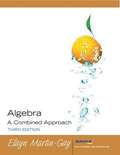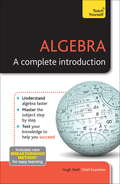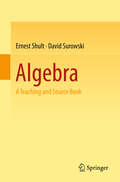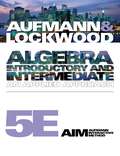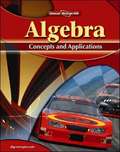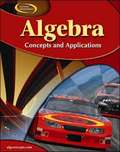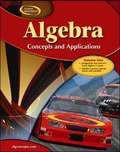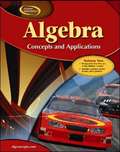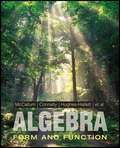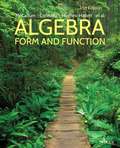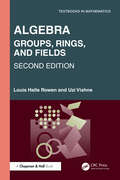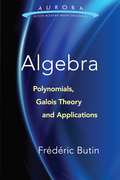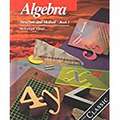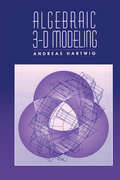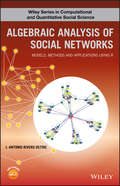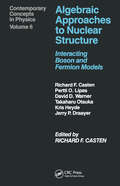- Table View
- List View
Algebra: A Combined Course: Concepts With Applications
by Charles P. McKeagueA Combined Course: Concepts With Applications
Algebra: A Complete Introduction (Teach Yourself)
by Hugh Neill P. AbbottAlgebra: A Complete Introduction is the most comprehensive yet easy-to-use introduction to using Algebra. Written by a leading expert, this book will help you if you are studying for an important exam or essay, or if you simply want to improve your knowledge. <P><P>The book covers all the key areas of algebra including elementary operations, linear equations, formulae, simultaneous equations, quadratic equations, logarithms, variation, laws and sequences.<P>Everything you will need is here in this one book. Each chapter includes not only an explanation of the knowledge and skills you need, but also worked examples and test questions.
Algebra: A Complete Introduction (Teach Yourself)
by Hugh Neill P. AbbottAlgebra: A Complete Introduction is the most comprehensive yet easy-to-use introduction to using Algebra.<P><P>Written by a leading expert, this book will help you if you are studying for an important exam or essay, or if you simply want to improve your knowledge. The book covers all the key areas of algebra including elementary operations, linear equations, formulae, simultaneous equations, quadratic equations, logarithms, variation, laws and sequences.Everything you will need is here in this one book. <P>Each chapter includes not only an explanation of the knowledge and skills you need, but also worked examples and test questions.Chapter 1: The meaning of algebra; Chapter 2: Elementary operations in algebra; Chapter 3: Brackets and operations with them; Chapter 4: Positive and negative numbers; Chapter 5: Equations and expressions; Chapter 6: Linear equations;Chapter 7: Formulae; Chapter 8: Simultaneous equations;Chapter 9: Linear inequalities;Chapter 10: Straight-line graphs; coordinates;Chapter 11: Using inequalities to define regions;Chapter 12: Multiplying algebraical expressions Chapter 13: Factors;Chapter 14: Fractions;Chapter 15: Graphs of quadratic functions;Chapter 16: Quadratic equations;Chapter 17: Indices;Chapter 18: Logarithms;Chapter 19: Ratio and proportion;Chapter 20: Variation;Chapter 21: The determination of laws;Chapter 22: Rational and irrational numbers and surds; Chapter 23: Arithmetical and geometric sequences
Algebra: A Computational Introduction (Studies in Advanced Mathematics)
by John Scherk<p>Adequate texts that introduce the concepts of abstract algebra are plentiful. None, however, are more suited to those needing a mathematical background for careers in engineering, computer science, the physical sciences, industry, or finance than Algebra: A Computational Introduction. Along with a unique approach and presentation, the author demonstrates how software can be used as a problem-solving tool for algebra. A variety of factors set this text apart. Its clear exposition, with each chapter building upon the previous ones, provides greater clarity for the reader. The author first introduces permutation groups, then linear groups, before finally tackling abstract groups. He carefully motivates Galois theory by introducing Galois groups as symmetry groups. He includes many computations, both as examples and as exercises. All of this works to better prepare readers for understanding the more abstract concepts. <p>By carefully integrating the use of Mathematica throughout the book in examples and exercises, the author helps readers develop a deeper understanding and appreciation of the material. The numerous exercises and examples along with downloads available from the Internet help establish a valuable working knowledge of Mathematica and provide a good reference for complex problems encountered in the field.</p>
Algebra: A Teaching and Source Book
by Ernest Shult David SurowskiThis book presents a graduate-level course on modern algebra. It can be used as a teaching book - owing to the copious exercises - and as a source book for those who wish to use the major theorems of algebra. The course begins with the basic combinatorial principles of algebra: posets, chain conditions, Galois connections, and dependence theories. Here, the general Jordan-Holder Theorem becomes a theorem on interval measures of certain lower semilattices. This is followed by basic courses on groups, rings and modules; the arithmetic of integral domains; fields; the categorical point of view; and tensor products. Beginning with introductory concepts and examples, each chapter proceeds gradually towards its more complex theorems. Proofs progress step-by-step from first principles. Many interesting results reside in the exercises, for example, the proof that ideals in a Dedekind domain are generated by at most two elements. The emphasis throughout is on real understanding as opposed to memorizing a catechism and so some chapters offer curiosity-driven appendices for the self-motivated student.
Algebra: An Applied Approach, Fifth Edition
by Richard N. Aufmann Joanne S. LockwoodIn the fifth edition of Algebra: Introductory and Intermediate, the focus remains on the Aufmann Interactive Method (AIM), as in the previous editions. Students are encouraged to be active participants in the classroom and in their own studies as they work through the How To examples and the paired Examples and You Try It problems. All lessons, exercise sets, tests, and supplements are organized around a carefully constructed hierarchy of objectives. This "objective-based" approach not only serves the needs of students, in terms of helping them to clearly organize their thoughts around the content, but instructors as well, as they work to design syllabi, lesson plans, and other administrative documents.
Algebra: Concepts and Applications
by Carol Malloy Jack Price Jerry Cummins Kay Mcclain Yvonne MojicaAn ideal program for struggling students "Glencoe Algebra: Concepts and Applications" covers all the Algebra 1 concepts. This program is designed for students who are challenged by high school mathematics.
Algebra: Concepts and Applications
by Glencoe McGraw-Hill StaffAn ideal program for struggling students Glencoe Algebra: Concepts and Applications covers all the Algebra 1 concepts. This program is designed for students who are challenged by high school mathematics.
Algebra: Concepts and Applications (Texas Edition)
by Carol Malloy Jack Price Jerry Cummins Kay Mcclain Yvonne MojicaGlencoe Algebra: Concepts and Applications includes lessons that will help students prepare for the Texas Essential Knowledge and Skills assessed on the Texas state test. This textbook contains a special section of practice problems specifically for the Texas state test.
Algebra: Concepts and Applications (Volume One)
by Carol Malloy Jack Price Jerry Cummins Kay Mcclain Yvonne MojicaAlgebra: Concepts & Applications, is a comprehensive Algebra 1 program that is available in full and two-volume editions. Algebra: Concepts & Applications uses a clean lesson design with many detailed examples and straightforward narration that make Algebra 1 topics inviting and Algebra 1 content understandable. Volume 1 contains Chapters 1-8 of Algebra: Concepts & Applications plus an initial section called Chapter A. Chapter A includes a pretest, lessons on prerequisite concepts, and a post test. Designed for students who are challenged by high school mathematics, the 2006 edition has many new features and support components.<P> <i>Advisory: Bookshare has learned that this book offers only partial accessibility. We have kept it in the collection because it is useful for some of our members. To explore further access options with us, please contact us through the Book Quality link on the right sidebar. Benetech is actively working on projects to improve accessibility issues such as these. </i>
Algebra: Concepts and Applications, Volume Two
by Carol Malloy Jack Price Jerry Cummins Kay Mcclain Yvonne MojicaAlgebra: Concepts & Applications, is a comprehensive Algebra 1 program that is available in full and two-volume editions. Algebra: Concepts & Applicationsuses a clean lesson design with many detailed examples and straightforward narration that make Algebra 1 topics inviting and Algebra 1 content understandable. Volume 1 contains Chapters 1-8 ofAlgebra: Concepts & Applicationsplus an initial section called Chapter A. Chapter A includes a pretest, lessonson prerequisite concepts, and a posttest. Designed for students who are challenged by high school mathematics, the 2007 edition has many new features and support components.
Algebra: Essentials and Applications
by Winston Holt RinehartAlgebra Essentials and Applications is focused, organized, and easy to follow. The program shows your students how to read, write, and understand the unique language of mathematics, so that they are prepared for every type of problem-solving and assessment situation.
Algebra: Form And Function
by Eric Connally Deborah Hughes-Hallett William G. MccallumThis book offers a fresh approach to algebra that focuses on teaching readers how to truly understand the principles, rather than viewing them merely as tools for other forms of mathematics. It relies on a storyline to form the backbone of the chapters and make the material more engaging. Conceptual exercise sets are included to show how the information is applied in the real world. Using symbolic notation as a framework, business professionals will come away with a vastly improved skill set.
Algebra: Form and Function (Second Edition)
by Eric Connally Elliot J. Marks Pat Shure Carl Swenson Deborah Hughes-Hallett Philip Cheifetz Ann Davidian Brigitte Lahme Patti Frazer Lock William G. Mccallum David Lovelock Ellen Schmierer Aysegul Sahin Adam H. Spiegler Selin KalaycýoðluAlgebra: Form and Function offers a fresh approach to algebra that focuses on teaching readers how to truly understand the principles, rather than viewing them merely as tools for other forms of mathematics. Meant for a College Algebra course, Algebra: Form and Function is an introduction to one of the fundamental aspects of modern society. Algebraic equations describe the laws of science, the principles of engineering, and the rules of business. The power of algebra lies in the efficient symbolic representation of complex ideas, which also presents the main difficulty in learning it. It is easy to forget the underlying structure of algebra and rely instead on a surface knowledge of algebraic manipulations. Most students rely on surface knowledge of algebraic manipulations without understanding the underlying structure of algebra that allows them to see patterns and apply it to multiple situations: McCallum focuses on the structure from the start.
Algebra: Groups, Rings, and Fields (Textbooks in Mathematics)
by Louis Halle Rowen Uzi VishneAlgebra is a subject we have become acquainted with during most of our mathematical education, often in connection with the solution of equations. Algebra: Groups, Rings, and Fields, Second Edition deals with developments related to their solutions.The principle at the heart of abstract algebra, a subject that enables one to deduce sweeping conclusions from elementary premises, is that the process of abstraction enables us to solve a variety of such problems with economy of effort. This leads to the glorious world of mathematical discovery.This second edition follows the original three-pronged approach: the theory of finite groups, number theory, and Galois’ amazing theory of field extensions tying solvability of equations to group theory.As algebra has branched out in many directions, the authors strive to keep the text manageable while at the same time introducing the student to exciting new paths. In order to support this approach, the authors broadened the first edition, giving monoids a greater role, and relying more on matrices. Hundreds of new exercises were added.A course in abstract algebra, properly presented, could treat mathematics as an art as well as a science. In this exposition, we try to present underlying ideas, as well as the results they yield.
Algebra: Groups, Rings, and Fields (Textbooks in Mathematics)
by Louis RowenThis text presents the concepts of higher algebra in a comprehensive and modern way for self-study and as a basis for a high-level undergraduate course. The author is one of the preeminent researchers in this field and brings the reader up to the recent frontiers of research including never-before-published material. From the table of contents: - Groups: Monoids and Groups - Cauchyís Theorem - Normal Subgroups - Classifying Groups - Finite Abelian Groups - Generators and Relations - When Is a Group a Group? (Cayley's Theorem) - Sylow Subgroups - Solvable Groups - Rings and Polynomials: An Introduction to Rings - The Structure Theory of Rings - The Field of Fractions - Polynomials and Euclidean Domains - Principal Ideal Domains - Famous Results from Number Theory - I Fields: Field Extensions - Finite Fields - The Galois Correspondence - Applications of the Galois Correspondence - Solving Equations by Radicals - Transcendental Numbers: e and p - Skew Field Theory - Each chapter includes a set of exercises
Algebra: Polynomials, Galois Theory and Applications
by Frédéric ButinSuitable for advanced undergraduates and graduate students in mathematics and computer science, this precise, self-contained treatment of Galois theory features detailed proofs and complete solutions to exercises. Originally published in French as Algèbre — Polynômes, théorie de Galois et applications informatiques, this 2017 Dover Aurora edition marks the volume's first English-language publication.The three-part treatment begins by providing the essential introduction to Galois theory. The second part is devoted to the algebraic, normal, and separable Galois extensions that constitute the center of the theory and examines abelian, cyclic, cyclotomic, and radical extensions. This section enables readers to acquire a comprehensive understanding of the Galois group of a polynomial. The third part deals with applications of Galois theory, including excellent discussions of several important real-world applications of these ideas, including cryptography and error-control coding theory. Symbolic computation via the Maple computer algebra system is incorporated throughout the text (though other software of symbolic computation could be used as well), along with a large number of very interesting exercises with full solutions.
Algebra: Structure and Method, Book 1
by Richard G. Brown Mary P. Dolciani Robert H. Sorgenfrey William L. ColeAn algebra book requires a different type of reading than a novel or a short story. Every sentence in a math book is full of information and logically linked to the surrounding sentences. You should read the sentences carefully and think about their meaning.
Algebra: Structure and Method, Book 1
by Richard G. Brown Mary P. Dolciani Robert H. Sorgenfrey William L. ColeAlgebra, Structure and Method textbook for ninth grade students.
Algebra: The Easy Way to Learn Algebra
by Hugh NeillAlgebra: A Complete Introduction is the most comprehensive yet easy-to-use introduction to using Algebra.Written by a leading expert, this book will help you if you are studying for an important exam or essay, or if you simply want to improve your knowledge. The book covers all the key areas of algebra including elementary operations, linear equations, formulae, simultaneous equations, quadratic equations, logarithms, variation, laws and sequences.Everything you will need is here in this one book. Each chapter includes not only an explanation of the knowledge and skills you need, but also worked examples and test questions.Chapter 1: The meaning of algebraChapter 2: Elementary operations in algebraChapter 3: Brackets and operations with themChapter 4: Positive and negative numbersChapter 5: Equations and expressionsChapter 6: Linear equationsChapter 7: FormulaeChapter 8: Simultaneous equationsChapter 9: Linear inequalitiesChapter 10: Straight-line graphs; coordinatesChapter 11: Using inequalities to define regionsChapter 12: Multiplying algebraical expressions Chapter 13: FactorsChapter 14: FractionsChapter 15: Graphs of quadratic functionsChapter 16: Quadratic equationsChapter 17: IndicesChapter 18: LogarithmsChapter 19: Ratio and proportionChapter 20: VariationChapter 21: The determination of lawsChapter 22: Rational and irrational numbers and surdsChapter 23: Arithmetical and geometric sequences
Algebraic 3-D Modeling
by Andreas HartwigWritten for researchers and developers of three-dimensional modeling programs, this book examines the variety of existing systems while investigating the practical limitations of available software. From the table of contents: - Polyhedra - Boundary Models - A Small Language Modeler - The Algebraic Model - Computation of Algebraic Manifolds - Topol
Algebraic Analysis of Social Networks: Models, Methods and Applications Using R (Wiley Series in Computational and Quantitative Social Science)
by J. Antonio OstoicPresented in a comprehensive manner, this book provides a comprehensive foundation in algebraic approaches for the analysis of different types of social networks such as multiple, signed, and affiliation networks. The study of such configurations corresponds to the structural analysis within the social sciences, and the methods applied for the analysis are in the areas of abstract algebra, combinatorics, and graph theory. Current research in social networks has moved toward the examination of more realistic but also more complex social relations by which agents or actors are connected in multiple ways. Addressing this trend, this book offers hands-on training of the algebraic procedures presented along with the computer package multiplex, written by the book’s author specifically to perform analyses of multiple social networks. An introductory section on both complex networks and for R will feature, however the subjects themselves correspond to advanced courses on social network analysis with the specialization on algebraic models and methods.
Algebraic Approach to Data Processing: Techniques and Applications (Studies in Big Data #115)
by Vladik Kreinovich Julio C. UrendaThe book explores a new general approach to selecting—and designing—data processing techniques. Symmetry and invariance ideas behind this algebraic approach have been successful in physics, where many new theories are formulated in symmetry terms. The book explains this approach and expands it to new application areas ranging from engineering, medicine, education to social sciences. In many cases, this approach leads to optimal techniques and optimal solutions. That the same data processing techniques help us better analyze wooden structures, lung dysfunctions, and deep learning algorithms is a good indication that these techniques can be used in many other applications as well. The book is recommended to researchers and practitioners who need to select a data processing technique—or who want to design a new technique when the existing techniques do not work. It is also recommended to students who want to learn the state-of-the-art data processing.
Algebraic Approaches to Nuclear Structure
by A. CastenholzThis book is devoted to algebraic models and their applications. It presents a simple, but thorough, pedagogic approach, starting from the most elementary ideas and building up to the most recent results of advanced theories. The book is designed for a graduate level treatment.
